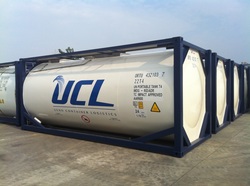Benefits of ISO Tank Containers
|
"ISO tank container can transport up to 60-70% more liquid cargo than drums on dry box containers"
"Flexibags are prone to leaks and spillage, not only costly, but environmentally unsustainable" |
"Loading & Discharge is safer, faster, and often times cheaper than drums and flexibags"
"ISO tanks last longer, reusable, and has high resale value compared to drums and bags" |

Reliability
ISO UN Portable tank containers are constructed to a very high standard and are rigorously tested under the ISO standards. They are manufactured from stainless steel which has a high corrosion resistance and it can withstand extreme forces as compared to drums or flexi-bags. All the valves are inspected and approved by the appropriate authorities and three closures are mandatory on all ISO tank containers. This means that the failures must occur at each of the three closures before the tank would leak.
Space Economy
ISO tanks can be stacked with one another or with dry box containers, offering economical space allocation on vessels and as temporary storage.
Efficiency
ISO tanks allow repetitive, large capacity haulage without the need for auxiliary packing materials. A 20-ft ISO tank container can transport up to 60-70% more cargo when compared against loading a regular 20-ft dry box container with drums. The pre-installed steam coil allows efficient loading/discharge of temperature sensitive liquids.
Greater Flexibility
ISO tank containers enable inter-modal logistics between various modes of transportation including sea vessels, trucks, and rails. It offers greater flexibility in planning as well as reducing costs and carbon footprints.
Environmentally Friendly
Reported leaks from ISO tank containers are extremely rare and the risk of spillage upon transportation/discharge is vastly reduced when compared against drums or flexi-bags. The ISO tank container is capable of carrying greater volume per container (up to 26,000 liters per tank) and can be transported on railroads; thereby greatly reducing carbon footprints. In addition, its versatility in carrying variety of cargoes effectively reduces the need for empty re-positioning. It also has a long lifespan (approximately 35 years) while drums and flexi-bags has a much shorter lifespan and are rarely recycled.
ISO UN Portable tank containers are constructed to a very high standard and are rigorously tested under the ISO standards. They are manufactured from stainless steel which has a high corrosion resistance and it can withstand extreme forces as compared to drums or flexi-bags. All the valves are inspected and approved by the appropriate authorities and three closures are mandatory on all ISO tank containers. This means that the failures must occur at each of the three closures before the tank would leak.
Space Economy
ISO tanks can be stacked with one another or with dry box containers, offering economical space allocation on vessels and as temporary storage.
Efficiency
ISO tanks allow repetitive, large capacity haulage without the need for auxiliary packing materials. A 20-ft ISO tank container can transport up to 60-70% more cargo when compared against loading a regular 20-ft dry box container with drums. The pre-installed steam coil allows efficient loading/discharge of temperature sensitive liquids.
Greater Flexibility
ISO tank containers enable inter-modal logistics between various modes of transportation including sea vessels, trucks, and rails. It offers greater flexibility in planning as well as reducing costs and carbon footprints.
Environmentally Friendly
Reported leaks from ISO tank containers are extremely rare and the risk of spillage upon transportation/discharge is vastly reduced when compared against drums or flexi-bags. The ISO tank container is capable of carrying greater volume per container (up to 26,000 liters per tank) and can be transported on railroads; thereby greatly reducing carbon footprints. In addition, its versatility in carrying variety of cargoes effectively reduces the need for empty re-positioning. It also has a long lifespan (approximately 35 years) while drums and flexi-bags has a much shorter lifespan and are rarely recycled.

